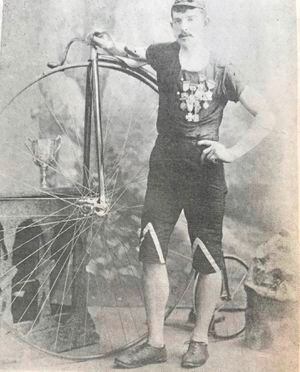From cycling's heady heights ... to six feet under
Rob Batiste on the untimely downfall of a Cobo high roller...

LE TOCQ is a good Cobo name.
Yet until a certain Jonathan came along to serve as the island’s chief minister for three years, there possibly had not been a more renowned Le Tocq than the young man who, 125 years earlier in Rue du Bouverie, had lived a stone’s throw from the politician’s Le Feugre home.
John Le Tocq was Cobo’s most famous son in the late 19th century, his performances on a penny farthing singling him out as one of the island’s sporting greats of the Victorian era.
It might have been an even greater career had it not been for a freak accident – complications of which, in the summer of 1890, took his life at the age of 29.
A blacksmith by trade, he had become the island’s first true great of cycling and his name was famous all over England.
But in late June 1890, while practising on the bicycle circuit at the Elizabeth College cricket field off King’s Road, he came a cropper when a rival cyclist, in fact his biggest rival, J. M. Duquemin, put on a late spurt and the Cobo champion fatefully cut across him.
It was not quite the high-speed spill which Chris Froome suffered last week and there are no reports of the Guernsey legend falling off while blowing his nose – very, very tricky on a penny farthing – but in the end it claimed his life.
At first it didn’t seem too serious.
The Comet of 2 July 1890 reported: ‘The collision was accidental – avoiding a soft patch of ground. One of Le Tocq’s knees was injured...
‘He received attention from a Dr Crowe at Victoria Road. He received further treatment at home and had hoped to take part in the five-mile Championship on 24 June. He was not fit enough to attend but was able to leave his room and stand at his front door.’
But then the situation took a turn for the worse...
‘He probably overrated his strength – caught a chill in his weakened body and tetanus set in. He sank rapidly, dying on 1 July. He was 29 years of age and left a widow.’
He had first come to prominence locally thanks to his efforts at the ‘Harbour Works’ circuit, which later became the Model Yacht Pond.
The Cobo flier became Guernsey champion and then Channel Islands title holder.
There was a great rivalry between himself and Duquemin, who was regarded as a potential successor and fellow member of the Guernsey Bicycle and Tricycle Club, which bore the cost of the great man’s funeral, as reported in The Comet: ‘The attendance included a large circle of friends, relatives and club members, including many fans, whom he had often entertained at the College grounds.
‘At 2.30 the cortege left Cobo cottage, the residence of the deceased, the remains enclosed in a pitch-pine coffin with silver-plated mountings and breastplate, the latter bearing the initials of the club, also the name, age and date of death.’
The pallbearers were all members of the club and on his final journey the procession walked up Les Pins and past Haye du Puits St George, the parochial school he had attended.
Castel School had yet to be built but its future site was probably passed as the cortege wound its way back north towards his burial at St Matthew’s Church.
In his address, the vicar described Le Tocq as ‘eminently a true, sober, honest man, a good son, tender husband, a cheerful companion and diligent at his occupation’.
From a humble beginning, he had raised himself to become one of the best known and respected islanders.
His grave, along with others, was vandalised, in the spring of 1971, mindlessly broken into four pieces.
Out of respect of the sport’s first ‘hero’, the Guernsey Velo Club dutifully repaired it and it remains prominent just inside the wall at the front of the church.
Of course, Cobo and its environs are much altered since the star cyclist’s day.
Terry Dowinton’s research of the 1881 census reveals just 10 households from Les Houmets and the top of what we know as Route de Cobo hill to Sous la Lande running underneath Le Guet on its eastern side.
What’s more, of the 66 men, women and children spread among those 10 properties, only three were born outside the St Mary de Castel area.
Next door to John Le Tocq’s parents was John Andre, a carpenter from Alderney, but among the collection of Le Tocqs, Girards and Ferbraches was the Great Western Railway clerk Thomas Guilbert. He lived just a quarter of a mile from where the beach picture on the facing page was taken with his wife Mary and 10 sons and daughters.
Nowadays the area is sufficiently changed by housing development that poor John would scarcely recognise the place, other than the little row of cottages where he settled to live a life cut so tragically short.





